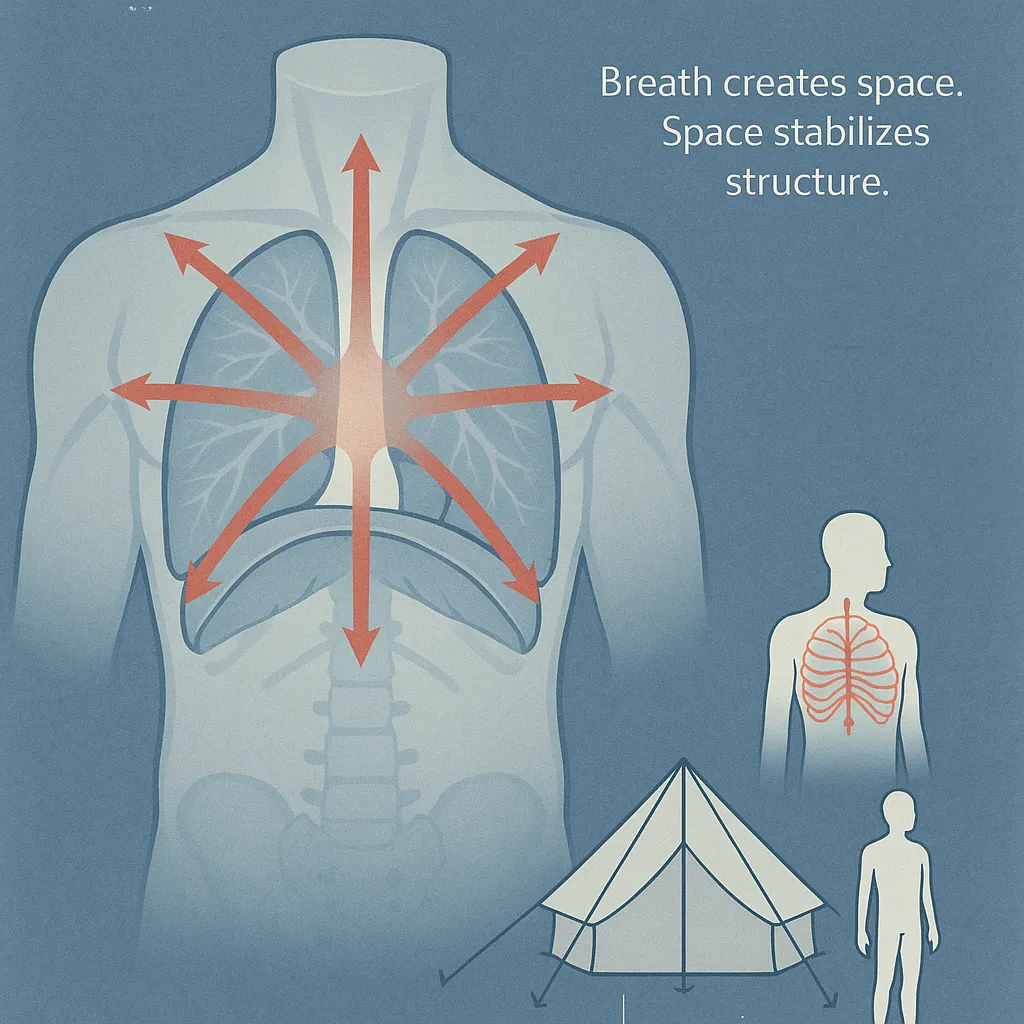
Suspended in Motion: The True Architecture of the Human Body
1. The Myth We Live Inside
Stand up for a moment. Let your arms hang. Feel the weight of your head, the ground under your feet.
Most of us imagine our skeleton as a neat stack of bones: feet → shins → thighs → pelvis → spine → skull.
It’s the image you’ve seen in every anatomy textbook. Clean. Linear. Logical.
And dead wrong.
Your bones never truly rest on each other. You are not a stack of bricks. You are a floating, pressurized suspension system — a living architecture where bones hang in a web of fascia, and breath keeps the whole thing inflated from the inside out.
Once you see this, you can’t go back. And once you feel it, every movement you make will change.

2. Why Structure Comes Before Strength
Before we talk about speed, power, or flexibility, we have to talk about structure.
Structure is the invisible blueprint that decides:
How force travels through you.
How your joints wear over time.
How your movement feels — heavy and grinding, or light and effortless.
If the structure is wrong, training hard just makes you break faster.
It’s like tuning the engine of a car with a bent chassis — more power, more instability.
3. Thought Experiment — Jump in Two Bodies
Close your eyes.
Body A: Picture yourself as a stack of bones. Land from a jump. The shock runs up from your heels, jams into your knees, then your hips. Your spine absorbs the rest.
Body B: Now imagine your bones floating in elastic lines of fascia. You land, and the tension web catches the load, spreading it through your whole body like a suspension bridge in a windstorm. Your joints barely feel the impact.
Same weight. Same jump. Different architecture. Which one survives a lifetime of movement?

4. The Old Models — And Why They Fail
4.1 The Compression Stack
Belief: Bones are stacked like bricks. Stability comes from precise alignment and compression.
Flaw: Works for stone, not for living tissue. Without tension, a pure compression structure collapses under dynamic load.
4.2 The Lever and Fulcrum
Belief: Bones are levers, joints are hinges, muscles are motors.
Flaw: The human body has no fixed fulcrum. Movement is spiraled, adaptive, and three-dimensional. Levers are rigid. We are not.

5. The Science of Suspension — Tensegrity

In the 1970s, orthopedic surgeon Stephen Levin noticed something odd:
Human joints didn’t behave like engineering hinges. They acted more like tensegrity structures — a concept from architecture where rigid rods (compression) are held apart by continuous cables (tension).
In your body:
Bones = compression struts.
Fascia, ligaments, tendons = continuous tension network.
Result: Force is distributed across the system, reducing joint strain and creating elastic movement.
Jean-Claude Guimberteau’s fascia imaging confirms it — under the skin, we are an unbroken web of collagen fibers, constantly adjusting to load.

6. The Missing Piece — Pressure (Axis 0)
Tensegrity explains stability, but it misses one thing: your body is alive, pressurized, and in constant motion.
Axis 0 is BAT’s missing dimension — the breath-driven hydraulic system that keeps you inflated from the inside.
Without pressure: Your bones sag inside the tension web. Movement flattens. Joints compress.
With pressure: Breath expands the internal space, holding bones apart, keeping the whole system load-ready.
Think of a tent:
The guy lines (fascia) keep the poles (bones) in place.
The air inside (pressure) gives the tent shape and resilience.

7. Self-Diagnosis — Are You Collapsing?
Try these two checks right now:
Posture Check: Stand and relax. If your ribs collapse down toward your pelvis, you’re losing internal pressure.
Breath Check: Inhale — does your torso expand 360° (front, sides, and back) or just lift your chest? If it’s the latter, your Axis 0 isn’t engaged.
If both fail, you’re moving in a compression-biased body — and paying for it in energy and joint health.
8. The BAT Structural Pyramid
The Body Alignment Training model captures all four structural layers:
Bone Compression Pyramid — skeletal alignment under balanced load.
Soft Tissue Tension Network — fascia suspending the skeleton.
Skin Container — the living boundary that keeps everything integrated.
Axis 0 (Pressure) — breath-driven hydraulics maintaining expansion.
Together, they make a body that’s stable yet mobile, strong yet efficient.

9. The Future-Pull — Training the System
When you understand your body as a tension–pressure system, you stop chasing symptoms.
You stop thinking “my knee hurts” and start asking “how is my whole structure handling force?”
You stop training muscles in isolation and start tuning the system.
This is the foundation. From here, we’ll look at how to build — and keep — a body that moves like a suspension bridge: stable, elastic, and ready for anything.
Closing Quote
“Structure without pressure is just a shape. Like a parachute with no air — it folds.”
